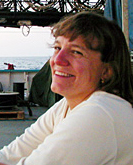It has been four years since my last oceanographic research cruise. It was July 2014 when I joined fellow scientists and graduate students in Iceland to board the Research Vessel Knorr to kick off an international expedition to put in place a huge coast-to-coast array of instruments across the North Atlantic Ocean. This array of instruments continuously measures ocean currents, water temperature and salinity from the sea floor to the sea surface. This project is called OSNAP, which stands for Overturning in the Subpolar North Atlantic Program (http://www.o-snap.org). Seven countries have put their resources together to undertake this important effort to monitor all the currents between Canada and Scotland that play a role in Earth’s climate system. The sensors have been hard at work measuring the ocean conditions since 2014, and after every couple of years, they need their batteries replaced.
So, it’s back to Iceland again, this time to board the newest research vessel operated by the Woods Hole Oceanographic Institution, the Research Vessel Neil Armstrong. We plan to depart from Iceland’s capital city, Reykjavik, on June 5, 2018, and spend three weeks in the waters east of Greenland pulling up the instruments, replacing batteries and then re-setting them.
This will be my first research cruise on the R/V Armstrong, and I’m very excited. I loved the R/V Knorr, the ship that took me on many an expedition around the world, but due to its age, it wasn’t the most accessible research vessel for a visually impaired scientist like me. The lighting was not great, the layout wasn’t very straight-forward, and there were tripping hazards all over the place. The R/V Armstrong on the other hand, has great modern lighting, stairways (called ladders on a ship, but they are more like slightly steep stairs) more like what one would find in any office building, and an arrangement of labs, cabins and offices that is neatly organized. While the Knorr was laid out like the streets of Boston, all going every which way, the Armstrong is like Washington, DC with it’s parallel streets and square blocks—much easier to navigate with a mobility (white) cane. Additionally, like a number of modern research vessels built recently in the U.S., there is even an ADA-compliant cabin for me to sleep in!
While I’m at sea, I’ll maintain the Ocean Insight blog much more regularly, as I have done for past expeditions in 2007 and 2014. You can see posts from those research cruises under the Expeditions heading on the Ocean Insight web site. I also plan to include new “audio postcards” and arrange live phone calls with students in classrooms at several schools for the blind and visually impaired. So, check back often in the coming months to follow this next adventure in oceanography.

 Amy Bower is a physical oceanographer at the Woods Hole Oceanographic Institution. She has been chasing ocean currents in the Atlantic and Indian Oceans for over 25 years, primarily by releasing acoustically tracked floats far below the sea surface. Legally blind since her mid-20s, Amy uses adaptive technology to continue her research.
Amy Bower is a physical oceanographer at the Woods Hole Oceanographic Institution. She has been chasing ocean currents in the Atlantic and Indian Oceans for over 25 years, primarily by releasing acoustically tracked floats far below the sea surface. Legally blind since her mid-20s, Amy uses adaptive technology to continue her research.